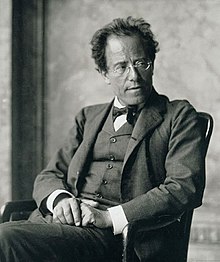
The musical compositions of Gustav Mahler (1860–1911) are almost exclusively in the genres of song and symphony. In his juvenile years he attempted to write opera and instrumental works; all that survives musically from those times is a single movement from a piano quartet from around 1876–78.[1] From 1880 onwards Mahler was a professional conductor whose composing activities had to be fitted around concert and theatrical engagements.[2] Nevertheless, over the next 30 years he produced nine complete symphonies and sketches for a tenth, several orchestral song cycles and many other songs with piano or orchestral accompaniment. Mahler's symphonies are generally on an expansive scale, requiring large forces in performance, and are among the longest in the concert repertoire.[3]
Mahler scholar Deryck Cooke divides Mahler's compositions into separate creative phases, preceded by a "juvenile" period up to 1880. The earliest surviving whole work is Das klagende Lied (The Song of Lament), a cantata for soloists, chorus and orchestra which was completed in 1880 just before Mahler took up his first conducting post.[1] In Cooke's chronology Mahler's first period as a mature composer extends over 20 years, to 1900, and includes his first four symphonies, his first song cycle Lieder eines fahrenden Gesellen ("Songs of a Wayfarer") and numerous other songs. The period includes Mahler's Wunderhorn phase, after his discovery in 1887 of the German folk-poems collected by Achim von Arnim and Clemens Brentano under the title Des Knaben Wunderhorn ("The Young Lad's Magic Horn"). Music critic Neville Cardus writes that this anthology nourished the composer's "pantheistic feelings about life and the world ... in which an all-embracing love [makes] all creatures kin."[4] Mahler set 24 of these poems to music; three were absorbed into his Second, Third and Fourth symphonies; nine were used to create Volumes II and III of Lieder und Gesänge ("Songs and Airs"), and the remaining 12 were grouped to form Mahler's own Wunderhorn song cycle.[3][5]
Cooke dates Mahler's "middle period" as between 1901 and 1907, covering the trio of instrumental symphonies (Fifth, Sixth and Seventh), the massive Eighth Symphony, and the settings of poems by Friedrich Rückert including the Kindertotenlieder cycle and the Rückert-Lieder.[6] The final period covers the last works: the symphonic Das Lied von der Erde ("The Song of the Earth") and the Ninth and Tenth Symphonies. None of these late works were performed during Mahler's lifetime. The unfinished Tenth Symphony was rendered by Deryck Cooke into a "performing version" which was first performed in London in 1964.[7][8]
- ^ a b Cite error: The named reference
Cooke21was invoked but never defined (see the help page). - ^ Cooke, p. 8
- ^ a b Cite error: The named reference
Franklinwas invoked but never defined (see the help page). - ^ Cardus, p. 55
- ^ Sadie, pp. 515–18
- ^ Sadie, pp. 518–23
- ^ Cooke, pp. 103–21
- ^ Cite error: The named reference
Sadie529was invoked but never defined (see the help page).